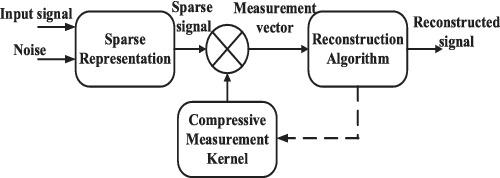当前位置:
X-MOL 学术
›
Int. J. Commun. Syst.
›
论文详情
Our official English website, www.x-mol.net, welcomes your feedback! (Note: you will need to create a separate account there.)
Decoding and measurement of frequency‐hopping spread spectrum signals using an adaptive algorithm‐based compressive sensing
International Journal of Communication Systems ( IF 2.1 ) Pub Date : 2020-11-03 , DOI: 10.1002/dac.4675 Sameh Ghanem 1
International Journal of Communication Systems ( IF 2.1 ) Pub Date : 2020-11-03 , DOI: 10.1002/dac.4675 Sameh Ghanem 1
Affiliation

|
Decoding of frequency‐hopping spread spectrum (FHSS) methods to intercept the symbol content in signals and brilliant measurement is presented in this paper. The switching of the frequency channels rapidly using a pseudorandom code makes interception of FHSS signals very difficult. Therefore, a proposed adaptive compressive measurement for decoding the frequency‐hopping receivers that have no prior knowledge of the hopping sequence is the main focus of this work. The proposed methods rely on the instantaneous sparsity of the spectra of FHSS signals, and the transmitted symbols can be recovered from the proposed compressive measurements. Furthermore, the contribution of this work is the design of a proposed adaptive method that is used to design measurement kernels for compressive measurement and decoding based on knowledge enhancement, which includes both prior information enhanced and adaptive methods based on the properties of the intersignals. Simulation results on Gaussian frequency‐shift keying (GFSK) FHSS signals illustrate that the proposed compressive method enhances the detection performance of the received frequencies with acceptable decoding accuracy compared with other techniques such as enhanced orthogonal matching pursuit (EOMP) and an adaptive sampling kernels method with a random compressive ratio. Also, an enhancement of the proposed algorithm is achieved due to enhancement in both the normalized mean square error (NMSE) and the probability of correction error (Pce). The comparison between these algorithms is performed using simulation based on MATLAB and receiver operating characteristic (ROC) curves.
中文翻译:

使用基于自适应算法的压缩感测对跳频扩频信号进行解码和测量
本文提出了一种跳频扩频(FHSS)方法的解码方法,以拦截信号中的符号内容并进行出色的测量。使用伪随机码快速切换频道使得截取FHSS信号非常困难。因此,这项工作的主要重点是提出一种用于对跳频序列没有先验知识的跳频接收机进行解码的自适应压缩测量方法。所提出的方法依赖于FHSS信号频谱的瞬时稀疏性,并且可以从所提出的压缩测量中恢复传输的符号。此外,这项工作的目的在于设计一种自适应方法,该方法用于基于知识增强来设计用于压缩测量和解码的测量内核,其中既包括增强的先验信息,又包括基于信号间属性的自适应方法。高斯频移键控(GFSK)FHSS信号的仿真结果表明,与增强正交匹配追踪(EOMP)和自适应采样核方法等其他技术相比,该压缩方法以可接受的解码精度提高了接收频率的检测性能。具有随机的压缩比。同样,由于归一化均方误差(NMSE)和校正误差的概率(高斯频移键控(GFSK)FHSS信号的仿真结果表明,与增强正交匹配追踪(EOMP)和自适应采样核方法等其他技术相比,该压缩方法以可接受的解码精度提高了接收频率的检测性能。具有随机的压缩比。同样,由于归一化均方误差(NMSE)和校正误差的概率(高斯频移键控(GFSK)FHSS信号的仿真结果表明,与增强正交匹配追踪(EOMP)和自适应采样核方法等其他技术相比,该压缩方法以可接受的解码精度提高了接收频率的检测性能。具有随机的压缩比。同样,由于归一化均方误差(NMSE)和校正误差的概率(P ce)。这些算法之间的比较是使用基于MATLAB和接收器工作特性(ROC)曲线的仿真进行的。
更新日期:2021-01-04
中文翻译:

使用基于自适应算法的压缩感测对跳频扩频信号进行解码和测量
本文提出了一种跳频扩频(FHSS)方法的解码方法,以拦截信号中的符号内容并进行出色的测量。使用伪随机码快速切换频道使得截取FHSS信号非常困难。因此,这项工作的主要重点是提出一种用于对跳频序列没有先验知识的跳频接收机进行解码的自适应压缩测量方法。所提出的方法依赖于FHSS信号频谱的瞬时稀疏性,并且可以从所提出的压缩测量中恢复传输的符号。此外,这项工作的目的在于设计一种自适应方法,该方法用于基于知识增强来设计用于压缩测量和解码的测量内核,其中既包括增强的先验信息,又包括基于信号间属性的自适应方法。高斯频移键控(GFSK)FHSS信号的仿真结果表明,与增强正交匹配追踪(EOMP)和自适应采样核方法等其他技术相比,该压缩方法以可接受的解码精度提高了接收频率的检测性能。具有随机的压缩比。同样,由于归一化均方误差(NMSE)和校正误差的概率(高斯频移键控(GFSK)FHSS信号的仿真结果表明,与增强正交匹配追踪(EOMP)和自适应采样核方法等其他技术相比,该压缩方法以可接受的解码精度提高了接收频率的检测性能。具有随机的压缩比。同样,由于归一化均方误差(NMSE)和校正误差的概率(高斯频移键控(GFSK)FHSS信号的仿真结果表明,与增强正交匹配追踪(EOMP)和自适应采样核方法等其他技术相比,该压缩方法以可接受的解码精度提高了接收频率的检测性能。具有随机的压缩比。同样,由于归一化均方误差(NMSE)和校正误差的概率(P ce)。这些算法之间的比较是使用基于MATLAB和接收器工作特性(ROC)曲线的仿真进行的。



























 京公网安备 11010802027423号
京公网安备 11010802027423号